No Results Found
The page you requested could not be found. Try refining your search, or use the navigation above to locate the post.
By Stephanie Oelsligle Jordan, Local Food Program Manager
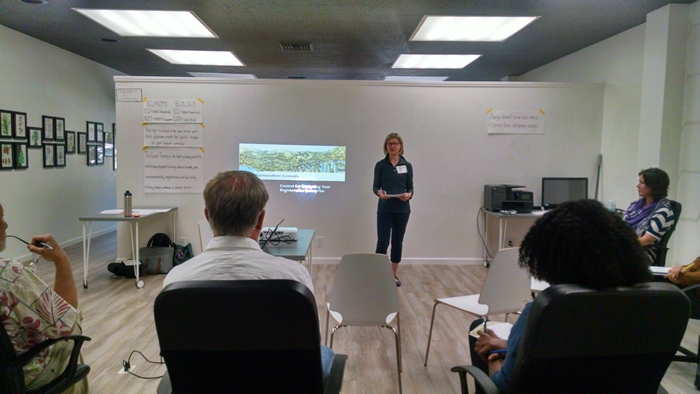
Between January and April, Santa Cruz Permaculture presented a series of four workshops entitled “Systems Change & the Next Economy: Regenerative Design for People & the Planet.” The series featured instructors with diverse backgrounds who are critically examining aspects of our economic, financial and monetary systems, as well as offering alternative models, inspiring examples and ideas for a new economic system that works for everyone.
My fellow Sustainable Solano co-workers had gone before me to the first three workshops, and on April 6 and 7, it was my turn. Led by Erin Axelrod and Kevin Bayuk of LIFT Economy, over the weekend we would “collectively explore the possibility of how we can redesign the economy to create regenerative outcomes of security, prosperity and a stable climate rather than outcomes of exploitation and inequity. By gaining an understanding of the design constraints of the ‘business as usual’ economy we will chart a pathway of transformation, using permaculture design principles, methods and ethics, to an economy that works for the benefit of all life. We will explore how to design enterprises and organizations that provide needed goods and services in ways that enhance and restore environmental and social prosperity.”
A tall order, but my group of around seven workshop participants jumped in with enthusiasm and curiosity.
We began by looking at the current problems: How currency use and certain economic activities have catalyzed a culture where humans don’t need anyone else — we only need money. (Or at least we think we don’t need anyone else.) This has resulted in lack of trust in people, only trust in money, and a laundry list of negative economic patterns (endless economic growth, greed, competition, prioritization of profit, commercialization, etc.) and skewed beliefs (“If I don’t have a leg up with inherited wealth, I’m not going to make it!”; “If you’re wealthy, that’s proof that you deserve more money!”; “If there’s a top category of wealthy people, there must be a bottom category”).
Erin pointed out that capitalism, as a system, has been good at suppressing alternatives and perpetuating itself, and making losers in the game. One point that I found fascinating was how humans are the only species with the concept of “unemployment,” and the idea that they/we have nothing to contribute. (Indeed, the squirrels scurrying around my backyard have endless work to do, within their functioning, natural ecosystem!)
So, now what?
Erin and Kevin argued that it is time to re-focus and think about how choices around business design and structure matter. What are models of creating businesses/organizations that don’t require passing on expenses to the end user? How can we find ways to meet our needs based on connection/community, and less on transaction/extraction? How can we design enterprises and organizations that provide needed goods and services in ways that enhance and restore environmental and social prosperity? Permaculture principles, which focus on “Earth Care, People Care and Fair Share,” provide the guiding star for this work. Is there a way to create an economy that works for the benefit of all life?
There are more questions than answers, but to try and arrive at some answers, Erin presented an interesting diagram:

Where we are now is at the top of the top curve, where the dotted line connects. “Business as usual” is the dotted line, which represents endless economic growth — but at the expense of others. The Hospice line represents activities that help the current system (with its inequities) to die off. The Midwifery line represents bringing in entirely new economic principles. And if all goes according to plan, we have a more equitable “Next Economy.”
There are lots of questions/issues around this graphic. Midwifery requires resources, which some organizations don’t have. Sometimes “hospice” is just keeping the bad from getting worse, and not actually working to stop dysfunctionality in the system. We then tried brainstorming examples of organizations that are practicing either “hospice” or “midwifery.” Patagonia would be one such example, as they are interested in repairing your (expensive) clothing, and not replacing it. They are trying to “hospice out” the “throw-away mentality” among consumers in the clothing industry and at the same time, “midwife” the idea of investing in fewer, higher-quality garments created in a fair trade system.
Another example that came up was TerraCycle. TerraCycle offers free recycling programs funded by brands, manufacturers and retailers around the world to help collect and recycle hard-to-recycle waste. But what I realized was that for TerraCycle to be completely effective, they need to be willing to go out of business. Some businesses that claim/work for good need to be so effective that they wouldn’t need to exist anymore.
We do have some organizations and people trying to do the right thing. But, when organizations/businesses are interfacing with the economy and trying to do the right thing, they hit a snag. Erin and Kevin call it the “Price Parity Paradox.” This means that when you are implementing a good/service and doing it “right” (equitable, environmentally sustainable, etc.), you end up with higher prices, making the thing inaccessible to those who might need it most. For example, let’s say I’m a community kitchen sourcing from small to mid-sized local farms (who practice sustainable agriculture) and paying fair prices for the ingredients. I’m also paying my staff – everyone from the dishwashers to the sous chefs – fair wages to produce nutrient-dense food. However, to maintain this business and be sustainable, my pricing needs to be at a certain level, which can only be afforded by wealthier people in the community. My products are too expensive and not accessible to certain populations who might need my nutrient-dense food the most (i.e. low income customers with health challenges).
All hope is not lost, however. Erin and Kevin presented some possible solutions to the Price Parity Paradox:
On the Demand Side:
This brought up more questions around perception of value: How do we get that shift where people are investing in things that benefit all life? Where are the people who are voluntarily ethical, and how did they get that perspective? How did they form value around certain things? Who are these self-selecting individuals opting in to pay more?
On the Supply Side:
Very few organizations are doing ALL supply and demand solutions to solve the Price Parity Paradox, but many are trying. It’s difficult because we are still operating within the constraints of the “business as usual” system. But let’s say you have an idea for an organization or business.
In our quest to design the Next Economy, we have circled back to the personal level. Here is another graphic that ties in personal purpose with an economic system:

As we wound down the weekend, I was reminded of the quote that Erin shared with us at the beginning of the weekend. It is from Adrienne Maree Brown, author of “Emergent Strategy: Shaping Change, Changing Worlds”:
Do you already know that your existence – who and how you are – is in and of itself a contribution to the people and place around you? Not after or because you do some particular thing, but simply the miracle of your life. And that the people around you, and the place(s), have contributions as well? Do you understand that your quality of life and your survival are tied to how authentic and generous the connections are between you and the people and place you live with and in?
⠀⠀⠀⠀⠀⠀⠀⠀⠀⠀⠀⠀⠀⠀⠀⠀⠀⠀⠀⠀⠀⠀
Are you actively practicing generosity and vulnerability in order to make the connections between you and others clear, open, available, durable? Generosity here means giving of what you have without strings or expectations attached. Vulnerability means showing your needs.
Changing a system is big work that requires years of travel down a long, long road. But by attempting to integrate some of these concepts into our lives, businesses and organizations, perhaps we can start to shift our culture. Perhaps we can have positive effects on other systems which are inextricably linked to our economic system, and perhaps someday we will be living within the “Next Economy.” Good luck!
The funding for Sustainable Solano’s team training at the “Next Economy” course at Santa Cruz Permaculture was provided by Solano Community Foundation through their NPP Capacity Building grants program. Community conversations are made possible through a grant from the Peaceful World Foundation. Thank you to both organizations!
The page you requested could not be found. Try refining your search, or use the navigation above to locate the post.
By Gabriela Estrada and Allison Nagel, Sustainable Solano
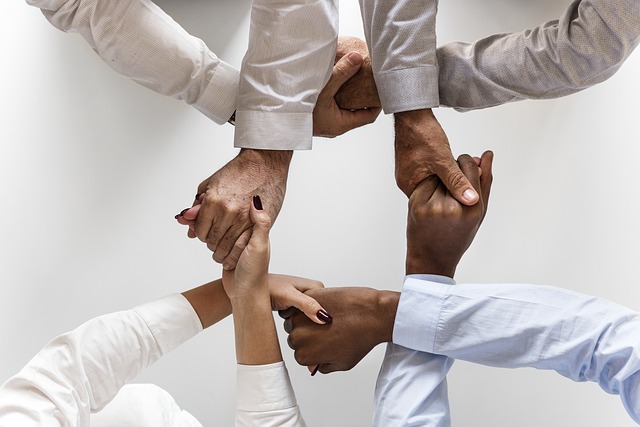
Communities have the power to shape a new economy that is equitable and just, and the transition to get there lies in creating self-determination and shared prosperity through community governance and community ownership. It also relies on moving from a mindset of scarcity to one of creating abundance.
At our recent Next Economy discussion, we explored these key elements and how they can be used, particularly within communities of color that have been disempowered and disenfranchised in the current economic system, to create a new way of approaching the economy that often draws upon traditions of supporting one another.
This discussion of Restorative Economics came from insight and lessons learned at a workshop led by project management consultant Nwamaka Agbo, who has a background in community organizing and restorative justice. Through our Next Economy series, we’ve tackled problems with the current economy and shared what we’ve learned about creating a new economy from the courses taken through Santa Cruz Permaculture’s Next Economy series, including Nwamaka’s workshop.
Restorative Economics addresses how to prioritize investment of resources back into impacted populations. Nwamaka focuses on creating a just transition that moves away from capitalism’s patterns of economic oppression that has harmed marginalized communities and placed power and wealth with a select few.
In particular, a just transition moves from:
We asked attendees to reflect on the fact that capitalism is a system, which means we have agency over it and we can change it. Keeping this in mind, we asked the group to think of some practices and values we could use for a just transition. As a group, we discussed the different ideas behind Restorative Economics and did some activities to think about both how we look at economics now and new ways to redefine the economy.
We shared Nwamaka’s tenets of Restorative Economics and some examples:
We wrapped up by thinking of what some of the biggest challenges are in our local community and how to address them. That included creating a system of affordable housing, better community gathering space and the recognition of the true value of labor. The idea of changing from a system that commodifies land, labor and capital to a system of land trust, right livelihood and public banking was also identified.
Join us at our next discussion on May 2 to explore ways to design our economic future.
As Nwamaka told us at the Santa Cruz workshop: “Change doesn’t come from intent. It comes from deliberate action.” That is the first step towards a more just economy that works for everyone.
The funding for Sustainable Solano’s team training at the “Next Economy” course at Santa Cruz Permaculture was provided by Solano Community Foundation through their NPP Capacity Building grants program. Community conversations are made possible through a grant from the Peaceful World Foundation. Thank you to both organizations!
We will continue to share insights at our final workshop at Green Hive Spaces in Vallejo. Please join us to further the discussion on the next economy in our community.
Designing the Regenerative Economy, 6 pm, May 2
Join us to discuss the design principles and strategies needed for vocation and regenerative enterprise design. We’ll discuss how we could redesign the economy for security, prosperity and a stable climate with transformation based on permaculture design principles, methods and ethics for an economy that benefits all life.
By Sustainable Solano
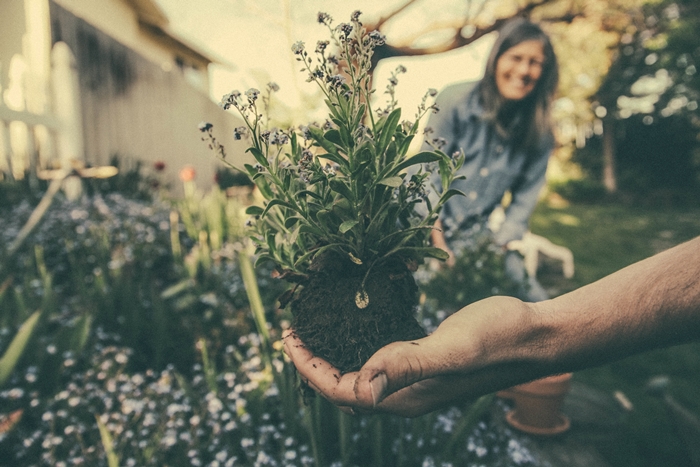
We’ve been doing a lot of thinking on the need to move to an economy that is informed by the indigenous ways of caring for both our local communities and our environment. So imagine our delight when we read a discussion between local economy advocates Helena Norberg-Hodge and Wendell Berry that ranges across human nature, technology, experiential knowledge, agriculture policy, happiness, wildness and local food systems.
Helena Norberg-Hodge is the founder and director of Local Futures, which works to renew ecological, social and spiritual well-being by promoting a systemic shift toward economic localization through decentralized, regional economies. Wendell Berry, poet, author and activist, is known for his advocacy for ecology, rural life and small-scale farming.
With permission from Helena Norberg-Hodge, who first recorded the conversation for her Local Futures podcast, we are reprinting a short excerpt below from the version that ran in Orion Magazine:
Norberg-Hodge: It’s also important to realize that the real problem is not human nature, but what I think of as an inhuman system. One of the biggest problems we’re facing is that the system has become so big that we can’t see what we’re doing and what we’re contributing to. Our economic system is of such an inhuman scale that it has become like a giant machine — a global juggernaut that’s pushing us all into fear and a terrible sense of scarcity.
Berry: What one has to say to begin with is that, as humans, we are limited in intelligence and we really have no reliable foresight. So none of us will come up with answers to the whole great problem. What we can do is judge our behavior, our history, and our present situation by a better standard than “efficiency” or “profit,” or those measures that we’re still using to determine economic decisions. The standard that I always come back to is the health of the world, which is the same as our own personal health. We can’t distinguish our health from the health of everything else. And we know enough from the ecologists now to know that health is a very complex and un-understandable complexity of relationships that makes the world whole.
Norberg-Hodge: Rather than those economic measures you referred to, the goal needs to be human and ecological well-being. And when people are more dependent on the living community around them — both the human and the nonhuman — then it becomes obvious that their well-being is connected to the well-being of the other.
Berry: It seems to me that it all depends upon our ability to accept limits. And the present economic system doesn’t even acknowledge limits. It is “develop[ing] resources” — which is to say, turning resources into riches (which is to say, money) — which leads almost inevitably to destruction. Money is an abstraction. Goods are particular, and always available within limits — natural limits, and the rightful limits of our consumption.
Norberg-Hodge: And in order for us to see those limits, we need a more human-scale, localized economy.
Berry: It would mean even more if we said a community economy, and we meant by economy the original sense of “household management” or “housekeeping.” That would imply taking the best possible care of the life supports of, first, the household economy, then the neighborhood economy, then the community economy. And we can go on from there on the principle of community, if we take it in the sense of “what we all have in common,” and an obligation to take care of all of it. But it will only be manageable locally, and within limits — the limits, among other things, of our own intelligence and our own capacity to act responsibly.
For the full conversation, which delves more richly into the interplay of the economy, the environment and the shift from global to local, listen to the podcast here or read the full transcript here.
By Stann Whipple, Sustainable Solano Treasurer
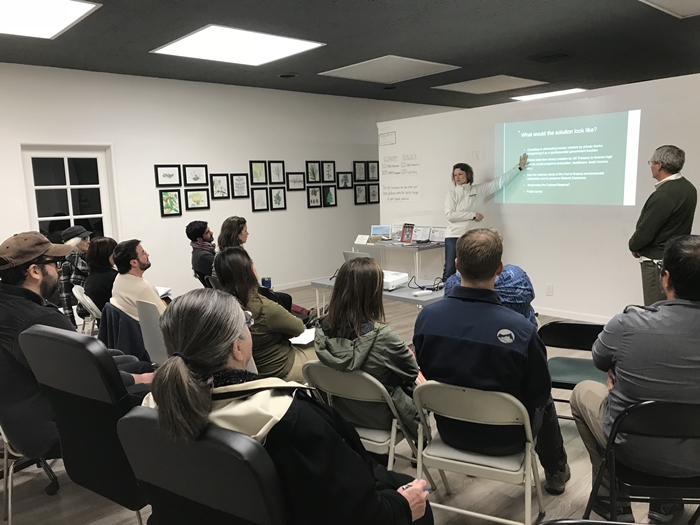
On March 7, a group of about 25 gathered at Green Hive Spaces in Vallejo for the third session of our “Next Economy” Conversations Series. From the beginning, we dived into the key issue of our current economic system: Who issues money and who decides on its use and how? Elena Karoulina and Stann Whipple presented new insights into why the current financial system is going the way it is and how we might begin to alter that course, based on concepts they learned at the recent workshop given by Marco Vangelisti through the Permaculture Institute in Santa Cruz.
Our money supply has three forms: 0.03% is in coins minted by the U.S. Treasury; 25% is paper notes printed and controlled by the Federal Reserve; and the remaining “money value” is accounted for electronically through the balance sheets of major banks as members of the FDIC. Banks can lend nine times against their savings. The Federal Reserve, which is privately owned by its member banks, has no constraints as to the amounts it can add to the money supply. As the banks and the Federal Reserve are mostly privately owned, the motive to make profits for their investors influences strongly where and how their money assets are allocated. Since the middle of last century the financial sector of the “market” has received over 70% of capital investments.
Historically — during the first half of the last century — there was still the understanding about earned and unearned income in the economy and how the role of the financial sector (banks and Wall Street) increased the wealth of all sectors through investments in the industrial and commercial sectors of the economy. In our evening presentation, we saw several charts depicting the change and separation of wealth in favor of the upper 5% of the population starting around 1970. Perhaps not coincidentally, the rise of neo-classical economic theories began to take precedent in the universities and financial markets around that time.
The current neo-classical view makes no distinction between earned and unearned income. The classical view of the “free market” stipulated that ONLY earned income should be “traded” in the economic markets. This was a deliberate step to move away from the feudalistic system of landlords and peasants where the landed gentry exacted “payments” as owners of the land. “Free” meant that income from labor and non-monopolistic activities was “earned” and income from rents on land, monopolistic profits and interests was “unearned.” The latter was deemed a re-allocating of values — not adding new values to the wealth of the economy. This has resulted in labor, land and capital to be traded as commodities.
Given this shift in defining what and how values can be recorded on the accounting balance sheets (along with corporations being accorded the same rights as “persons”), the disparity between the upper 5% and the remaining 95% will continue. The evening concluded with two presentations about recent initiatives striving to work more democratically with investment in property from Ojan Mobedshahi with the East Bay Permanent Real Estate Cooperative in Oakland and for a local food system from Paula Schnese, a founder of Cultivate Community Food Co-op here in Solano County.
We can look forward to the next conversation on April 4 giving us further understanding for the economy and how to shape it to serve our local communities for the future.
The funding for Sustainable Solano’s team training at the “Next Economy” course at Santa Cruz Permaculture was provided by Solano Community Foundation through their NPP Capacity Building grants program. Community conversations are made possible through a grant from the Peaceful World Foundation. Thank you to both organizations!
We will continue to share insights at upcoming workshops at Green Hive Spaces in Vallejo in the coming months. Please join us at one or all of these events to further the discussion on the next economy in our community.
Restorative Economics, 6 pm, April 4
Join us for a discussion on different strategies for a just transition to a more sustainable, equitable and just economy. Restorative economics takes a restorative justice approach to restoring and reinvesting in low-income communities of color through the establishment of community-owned and community-governed projects for self-determination and shared prosperity.
Designing the Regenerative Economy, 6 pm, May 2
Join us to discuss the design principles and strategies needed for vocation and regenerative enterprise design. We’ll discuss how we could redesign the economy for security, prosperity and a stable climate with transformation based on permaculture design principles, methods and ethics for an economy that benefits all life.
By Kassie Munro and Nicole Newell, Program Managers
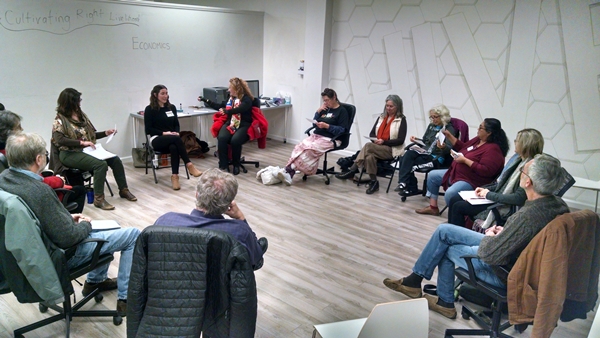
The economy can be difficult to understand, yet we all can identify the many problems that we are facing as individuals and as a society in our current system. Sustainable Solano has committed to attend the Systems Change & the Next Economy workshop series presented by Santa Cruz Permaculture and report back on what was learned through a series of presentations and community circles at Green Hive Spaces in Vallejo. This gives us an opportunity to explore solutions on how to create a world that benefits the whole within our Solano County community.
Economist Della Duncan presented the first workshop we attended in Santa Cruz, titled Cultivating Right Livelihood: Embark on the path of inner and outer transitions for a more beautiful and sustainable world.
It was a weekend of questioning the goals of our current broken economic system and soul-searching to find our place in the solution. Each section that she taught began with a tingsha meditation bell and a mindfulness practice; feet on the ground, elongated spine and paying attention to breath. She created a safe space to be vulnerable and explore our inner world and provided opportunities for us to share our insights with each other.
The workshop can be described in the Frederick Buechner quote that Della modified: “Your right livelihood is the place where your deep gladness meets the world’s hunger at your highest potential.”
Right Livelihood doesn’t have to be something that you are paid for. Ask yourself these questions:
Many of the problems facing our communities today are daunting and can leave us feeling overwhelmed. The workshop focused on self-reflection and helping to make sense of the current world inside our own hearts and minds. Rather than suggest solutions to the world’s economic problems, Della invited us to consider alternative ways of thinking about the economic system and its shortcomings and focused on ways that we can take action in our own lives. These actions may not change the world overnight, but they give us hope in the face of the unknown and allow us to take comfort in participating in shaping the future, which is all that can be asked of any one person.
Sharing an abbreviated version of our learnings, and opening up about our personal experience at the workshop with our community here in Solano County was insightful. The complexity of our planet’s current economic, political, cultural and environmental condition is an emotional subject. Creating a safe place for our neighbors to come together and share their personal experiences — hopes, fears, aspirations — is an important part of the journey forward. It was inspiring to see members of the community come out to be part of the discussion and share their interest in finding solutions.
The funding for Sustainable Solano’s team training at the “Next Economy” course at Santa Cruz Permaculture was provided by Solano Community Foundation through their NPP Capacity Building grants program. Community conversations are made possible through a grant from the Peaceful World Foundation. Thank you to both organizations!
We will continue to share insights at upcoming workshops at Green Hive Spaces in Vallejo in the coming months. Please join us at one or all of these events to further the discussion on the next economy in our community.
Essential Knowledge for Transition, 6 pm, March 7
Few of us realize the extent to which the design of the money system, the economic system and the financial system constrains our choices and frustrates our desire to bring forth a more healthy and compassionate world. The purpose of this talk will be to provide an accessible understanding of money, the economy and investing.
Restorative Economics, 6 pm, April 4
Join us for a discussion on different strategies for a just transition to a more sustainable, equitable and just economy. Restorative economics takes a restorative justice approach to restoring and reinvesting in low-income communities of color through the establishment of community-owned and community-governed projects for self-determination and shared prosperity.
Designing the Regenerative Economy, 6 pm, May 2
Join us to discuss the design principles and strategies needed for vocation and regenerative enterprise design. We’ll discuss how we could redesign the economy for security, prosperity and a stable climate with transformation based on permaculture design principles, methods and ethics for an economy that benefits all life.

At the end of January we spent a few intense days at the Eco Farm Conference, which is becoming our annual tradition. Away from the complexity of daily routines and a web of Sustainable Solano activities, we were able to focus exclusively on the emerging local food system in our county and to learn from leaders and advocates of this movement.
While the topics of discussion were many, the key idea was clear: Feeding seven billion people is not a small task and agriculture is here to stay. The major question is, what kind of agriculture? As the conference progressed, we spent time reflecting on the consequences of using synthetic nitrogen introduced in the early 20th century, which allowed the production of massive amounts of “cheap” food at the cost of a decrease in quality and nutritional density of this very food as well as the degradation of the planet. This overproduction of commodity crops for profit supported intensive population growth, but the quality of food did not ensure health for the majority of humanity.
We also discussed the importance of yield and how we pushed nature to its limits with our intensive technologies, beginning with the Green Revolution. It became clear that reproduction is the biggest energy sink, and that plants exhaust their energy reserve to deliver the higher and higher yield we demand from them; compromising all their other systems in the process. This results in weak plants that are susceptible to pests and disease and require an increasing number of pesticides, herbicides and other poisons to simply survive.
Eventually we will have to wean ourselves from synthetic fertilizers and return to a more balanced way of producing food. Critics of holistic agriculture (such as true organic, biodynamic, permaculture, regenerative agriculture and others) are quick to point out that the yield of these approaches will not support the demand of a growing population. However, there is such a distortion of truth in the global food economy, where subsidies and tariffs obscure the true cost of food. These costs include the cost to the communities and the environment. We produce grains for cattle, corn for syrup, and food for profit, making it difficult to assess available land and other resources to produce simply food.
As we always say, Solano County is a microcosm of the world. We have two types of agriculture side by side all around us. Large industrial agriculture produces over $350 million worth of products annually that are exported to 44 countries. Smaller, community-oriented farming is here too! Organic farms, such as Eat Well Farm, Cloverleaf, Lockwood Acres, CoCo Ranch; sustainably managed Brazelton Ranch; the lavender fields and olive groves of Soul Food Farm; Ilfar; farm stands; and wineries of Suisun Valley and Pleasants Valley need our support and attention!
Together with our community partners, we are seeking to strengthen our local food system, make it economically and ecologically sustainable and socially just. Justice and equity of food systems was another key focus of the Eco Farm Conference this year. We heard from numerous organizations from across the nation struggling to build a more equitable world. This is an enormously difficult area, with no clear answers yet, but with many promising and inspiring examples and leaders emerging all over the country.
Indigenous wisdom was another key component of everything we discussed at the conference. Biodiversity in and around fields is a crucial component of sustainable agriculture. Time-tested, wise ways of managing our local ecosystem must inform any work done in local agriculture and local food systems.
The three days of the conference were packed with technical knowledge and assistance to the farmers, with topics ranging from tractors to taxes, and with many workshops for the support ecosystems, FSMA (Food Safety Modernization Act), food hubs, marketing, legal, policy, even grant writing.
We gathered together at the last hour of the conference, tired but inspired and excited to continue to carry this work forward in our communities. The last key speaker brought us back to where it started and where it all needs to point to: to the sacredness of nature and food as its gift, to the reverence for Earth and all forms of life, to interconnectedness and interdependence of everything and everyone…
Soil is the foundation of life and soil fertility is what life depends upon. Resilience is fertile!